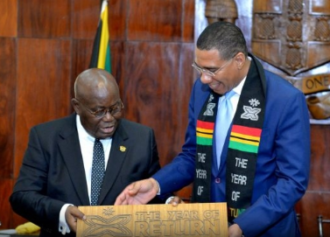His credentials uniquely unchallengeable, Sir Shridath Ramphal fearlessly raised the “West Indies” banner, at a time when Trinidad and Tobago (T&T), and Jamaica, are marking 50 years as jealously independent states. Over half a century of separatism, the West Indies, as an idea, as a place name, and as a real-world entity, has become more and more dated.
Little more than a cricket team and a university remain to carry the West Indian brand proudly forward. Certainly, at an individual level, Sir Shridath identifies as the singular patron-advocate of the belief that recognizes in this region a commonality of historical experience and of aspiration and destiny.
Delivering the 26th annual Eric Williams Memorial Lecture at the Central Bank last Saturday, the Caribbean statesman and diplomat lived up to expectations. A Guyana native, this iconic figure reopened the question of regional unity, that is so often treated as closed, or as belonging to the past. He did so by recalling Trinidad and Tobago’s important historical investments in the integration project.
Back in 1970, T&T Prime Minister Eric Williams had recognized Sir Shridath as a fellow laborer in the “vineyard” of integration. The late Dr Williams, one of the leaders who brought into being the short-lived West Indies Federation, is also remembered as the one who finally pulled the plug. After Jamaican referendum voters had chosen to quit the Federation, the T&T leader infamously scuttled what was left with his determination: “One from ten leaves nought”.
Without T&T and without Jamaica, the Federation came to naught. But the idea of regional integration has remained alive.
Sir Shridath on Saturday speculated on what might have been, had the Federation survived. He pictured a state comprising more than six million people, which would have “commanded our national pride and international respect”.
That federal state, he argued, could have, among other things, secured political freedoms; maximized use of regional economic resources; enhanced security; reduced brain-drain losses; and strengthened hands in negotiations with international institutions and foreign countries.
His clear message, however, was that of a mandate for T&T, based on the leadership played by former leaders. Following the federal collapse, Dr Williams had advanced efforts toward economic integration, leading eventually to the 1973 Treaty of Chaguaramas, and called for a single centre of decision-making. By 1989, Prime Minister ANR Robinson had led the process which resulted in the comprehensive scope of the Grand Anse Declaration.
The present Prime Minister is yet to distinguish herself on the regional front. Over this, consummate diplomat Sir Shridath avoided blunt expression of disappointment. He did, however, leave the message that the regional movement needs T&T, most of all, as an “intellectual leader”.
So defined, this is the level to which Prime Minister Kamla Persad-Bissessar must rise, to stay true to historical expectation, and to deliver on the promise of regional integration.
Source: Trinidadexpress.com


